Abstract
Alternate splicing of mRNA encoding c-KIT results in isoforms which differ in the presence or absence of four amino acids (GNNK) in the juxtamembrane region of the extracellular domain of the receptor. In this study we show that these isoforms of human c-KIT, expressed at similar levels in NIH3T3 cells, display differential effects on various attributes of transformation. The GNNK− isoform strongly promoted anchorage independent growth (colony formation in semi-solid medium), loss of contact inhibition (focus formation), and led to tumorigenicity in nude mice. In contrast, the GNNK+ isoform elicited colony formation but relatively poor focus formation and no tumorigenicity. Saturation binding analysis indicated that the isoforms do not differ significantly in their affinity for the KIT ligand, Steel Factor (SLF). Negligible ligand-independent receptor phosphorylation was observed in either case but, after ligand stimulation, the GNNK− isoform displayed more rapid and extensive tyrosine autophosphorylation and faster internalization. Both isoforms recruited the p85 subunit of phosphatidylinositol 3-kinase and led to similar phosphorylation of its downstream effector c-Akt, but the GNNK− isoform gave rise to more MAP kinase phosphorylation. Thus the c-KIT isoforms display different signalling characteristics and have different transforming activity in NIH3T3 cells.
This is a preview of subscription content, access via your institution
Access options
Subscribe to this journal
Receive 50 print issues and online access
$259.00 per year
only $5.18 per issue
Buy this article
- Purchase on Springer Link
- Instant access to full article PDF
Prices may be subject to local taxes which are calculated during checkout







Similar content being viewed by others
References
Alexander WS, Lyman SD and Wagner EF. . 1991 EMBO J. 10: 3683–3691.
Besmer P, Murphy JE, George PC, Qui F, Bergold PJ, Lederman L, Snyder HW, Brodeur D, Zuckerman EE and Hardy WD. . 1986 Nature 320: 415–421.
Brizzi MF, Blechman JM, Cavalloni G, Givol D, Yarden Y and Pegoraro L. . 1994 Oncogene 9: 1583–1589.
Caruana G, Cambareri AC, Gonda TJ and Ashman LK. . 1998 Oncogene 16: 179–190.
Cole SR, Aylett GW, Casey G, Harvey NL, Cambareri AC and Ashman LK. . 1996 Leukemia 10: 288–296.
Cox AD, Brtva TR, Lowe DG and Der CJ. . 1994 Oncogene 9: 3281–3288.
Crosier PS, Ricciardi ST, Hall LR, Vitas MR, Clark SC and Crosier KE. . 1993 Blood 82: 1151–1158.
DeBerry C, Mou S and Linnekin D. . 1997 Biochem. J. 327: 73–80.
Franke TF, Kaplan DR, Cantley LC and Toker A. . 1997 Science 275: 665–668.
Furitsu T, Tsujimura T, Tono T, Ikeda H, Kitayama H, Koshimizu U, Sugahara H, Butterfield JH, Ashman LK, Kanayama Y, Matsuzawa Y, Kitamura Y and Kanakura Y. . 1993 J. Clin. Invest. 92: 1736–1744.
Hayashi S-I, Kunisada T, Ogawa M, Yamaguchi K and Nishikawa S. . 1991 Nucl. Acids Res. 19: 1267–1271.
Herbst R, Munemitsu S and Ullrich A. . 1995a Oncogene 10: 369–379.
Herbst R, Shearman MS, Jallal B, Schlessinger J and Ullrich A. . 1995b Biochem. 34: 5971–5979.
Kennedy SG, Wagner AJ, Conzen SD, Jordan J, Bellacosa A, Tsichlis PN and Hay N. . 1997 Genes Dev. 11: 701–713.
Khwaja A, Rodriguez-Viciana P, Wennström S, Warne PH and Downward J. . 1997 EMBO J. 16: 2783–2793.
Lev S, Givol D and Yarden Y. . 1991 EMBO J. 10: 647–654.
Linnekin D, DeBerry CS and Mou S. . 1997 J. Biol. Chem. 272: 27450–27455.
Mann R, Mulligan RC and Baltimore D. . 1983 Cell 33: 153–159.
Marte BM, Rodriguez-Viciana P, Wennström S, Warne PH and Downward J. . 1997 Curr. Biol. 7: 63–70.
Marte BM and Downward J. . 1997 T.I.B.S. 22: 355–358.
Matsuguchi T, Salgia R, Hallek M, Eder M, Druker B, Ernst TJ and Griffin JD. . 1994 J. Biol. Chem. 269: 5016–5021.
Olson MF, Paterson HF and Marshall CJ. . 1998 Nature 394: 295–299.
Piao X, Curtis JE, Minkin S, Minden MD and Bernstein A. . 1994 Blood 83: 476–481.
Rankin S and Rozengurt E. . 1994 J. Biol. Chem. 269: 704–710.
Rayner JR and Gonda TJ. . 1994 Mol. Cell. Biol. 14: 880–887.
Reith AD, Ellis C, Lyman SD, Anderson DM, Williams DE, Bernstein A and Pawson T. . 1991 EMBO J. 10: 2451–2459.
Rottapel R, Reedijk M, Williams DE, Lyman SD, Anderson DM, Pawson T and Bernstein A. . 1991 Mol. Cell. Biol. 11: 3043–3051.
Ruoslahti E and Reed JC. . 1994 Cell 77: 477–478.
Serve H, Yee NS, Stella G, Sepp-Lorenzino L, Tan JC and Besmer P. . 1995 EMBO J. 14: 473–483.
Sewing A, Wiseman B, Lloyd AC and Land H. . 1997 Mol. Cell. Biol. 17: 5588–5597.
Tang B, Mano H, Yi T and Ihle JN. . 1994 Mol. Cell. Biol. 14: 8432–8437.
Traverse S, Gomez N, Paterson H, Marshall C and Cohen P. . 1992 Biochem. J. 288: 351–355.
Vieira AV, Lamaze C and Schmid SL. . 1996 Science 274: 2086–2089.
Weiler SR, Mou S, DeBerry CS, Keller JR, Ruscetti FW, Ferris DK, Longo Dl and Linnekin D. . 1996 Blood 87: 3688–3693.
Wisniewski D, Strife A, Berman E and Clarkson B. . 1996 Leukemia 10: 229–237.
Woods D, Parry D, Cherwinski H, Bosch E, Lees E and McMahon M. . 1997 Mol. Cell. Biol. 17: 5598–5611.
Yarden Y, Kuang W-J, Yang-Feng T, Coussens L, Munemitsu S, Dull TJ, Chen E, Schlessinger J, Francke U and Ullrich A. . 1987 EMBO J. 6: 3341–3351.
Yee NS, Langen H and Besmer P. . 1993 J. Biol. Chem. 268: 14189–14201.
Yi T and Ihle JN. . 1993 Mol. Cell. Biol. 13: 3350–3358.
Zhu WM, Dong WF and Minden M. . 1994 Leuk. Lymph. 12: 441–447.
Acknowledgements
We thank Ly Nguyen for skilled technical assistance, Paul Sincock for help with confocal microscopy, Sonia Young for contributing binding data on PC12 cells, and Regan Forrest for carrying out preliminary signalling experiments. This work was supported by a grant from the National Health and Medical Research Council of Australia of which LK Ashman is a Senior Research Fellow, and by an Australian Postgraduate Award to G Caruana.
Author information
Authors and Affiliations
Rights and permissions
About this article
Cite this article
Caruana, G., Cambareri, A. & Ashman, L. Isoforms of c-KIT differ in activation of signalling pathways and transformation of NIH3T3 fibroblasts. Oncogene 18, 5573–5581 (1999). https://doi.org/10.1038/sj.onc.1202939
Received:
Revised:
Accepted:
Published:
Issue Date:
DOI: https://doi.org/10.1038/sj.onc.1202939
Keywords
This article is cited by
-
CD117/c-kit defines a prostate CSC-like subpopulation driving progression and TKI resistance
Scientific Reports (2021)
-
Perspectives on the role of brain cellular players in cancer-associated brain metastasis: translational approach to understand molecular mechanism of tumor progression
Cancer and Metastasis Reviews (2018)
-
The stem cell factor (SCF)/c-KIT signalling in testis and prostate cancer
Journal of Cell Communication and Signaling (2017)
-
Identification of the two KIT isoforms and their expression status in canine hemangiosarcomas
BMC Veterinary Research (2016)
-
Expression and localisation of c-kit and KITL in the adult human ovary
Journal of Ovarian Research (2015)



